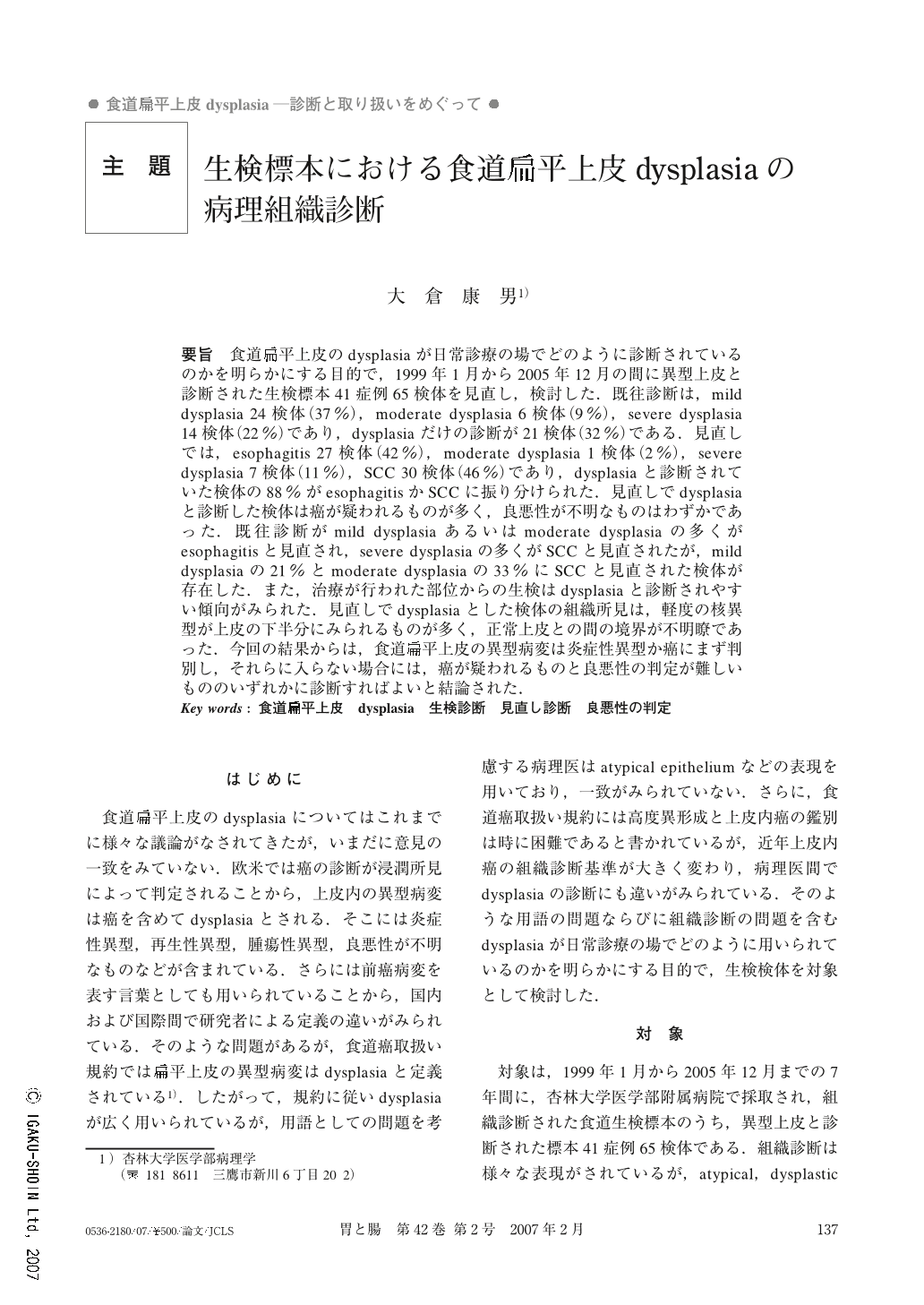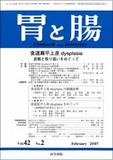Japanese
English
- 有料閲覧
- Abstract 文献概要
- 1ページ目 Look Inside
- 参考文献 Reference
- サイト内被引用 Cited by
要旨 食道扁平上皮のdysplasiaが日常診療の場でどのように診断されているのかを明らかにする目的で,1999年1月から2005年12月の間に異型上皮と診断された生検標本41症例65検体を見直し,検討した.既往診断は,mild dysplasia 24検体(37%),moderate dysplasia 6検体(9%),severe dysplasia 14検体(22%)であり,dysplasiaだけの診断が21検体(32%)である.見直しでは,esophagitis 27検体(42%),moderate dysplasia 1検体(2%),severe dysplasia 7検体(11%),SCC 30検体(46%)であり,dysplasiaと診断されていた検体の88%がesophagitisかSCCに振り分けられた.見直しでdysplasiaと診断した検体は癌が疑われるものが多く,良悪性が不明なものはわずかであった.既往診断がmild dysplasiaあるいはmoderate dysplasiaの多くがesophagitisと見直され,severe dysplasiaの多くがSCCと見直されたが,mild dysplasiaの21%とmoderate dysplasiaの33%にSCCと見直された検体が存在した.また,治療が行われた部位からの生検はdysplasiaと診断されやすい傾向がみられた.見直しでdysplasiaとした検体の組織所見は,軽度の核異型が上皮の下半分にみられるものが多く,正常上皮との間の境界が不明瞭であった.今回の結果からは,食道扁平上皮の異型病変は炎症性異型か癌にまず判別し,それらに入らない場合には,癌が疑われるものと良悪性の判定が難しいもののいずれかに診断すればよいと結論された.
Sixty-five esophageal biopsy specimens, diagnosed as dysplasia from 1999 to 2005 in Kyorin University School of Medicine, were re-examined. Biopsy specimens were diagnosed by fourteen general pathologists. The diagnoses were 24 specimens (37%) of mild dysplasia, 6 specimens (9%) of moderate dysplasia, 14 specimens (22%) of severe dysplasia and 21 specimens (32%) of dysplasia alone without grading. After re-examination 27 specimens (42%) are esophagitis, 1 specimen (2%) is moderate dysplasia, 7 specimens (11%) are severe dysplasia and 30 specimens (46%) are squamous cell carcinoma (SCC). Most of the specimens are diagnosed as esophagitis without atypia and SCC. Cases of dysplasia are not so many, and its characteristic histological figure located at the line of demarcation between atypical epithelium and normal epithelium is not well defined. Pathologists easily use the word "dysplasia" in accord with information of past history of therapy such as EMR, radiation and chemotherapy. Most mild and moderate dysplasia in previous diagnosis is re-diagnosed as espohagitis, and most severe dysplasia is re-diagnosed as SCC. However, five specimens (21%) of mild dysplasia in previous diagnosis and 2 specimens (33%) of moderate dysplasia are re-diagnosed as SCC. Histological figures of those specimens showed slight enlargement of nucleori, slight increase of nucleo-cytoplasmic ratio and slight loss of polarity, which factor are found in the lower part of the epithelium. Pathologists should know those figures thoroughly in diagnosing atypical esophageal epithelium. From the above results it can be seen that pathologist diagnose atypical esophageal epithelium as esophagitis or SCC at first, and then the borderline lesion between them is divided into two categories which are the indefinite lesion which cannot be diagnosed as benign or malignant and the malignant lesion suspected to be carcinoma.

Copyright © 2007, Igaku-Shoin Ltd. All rights reserved.


